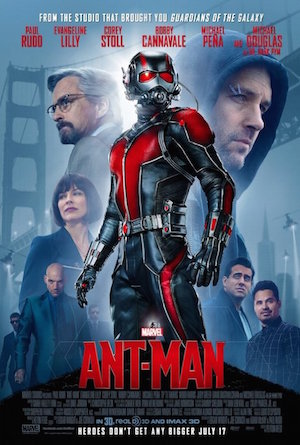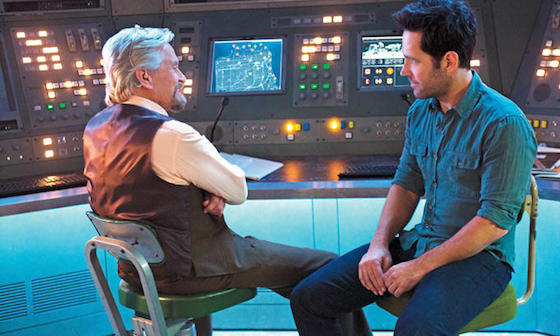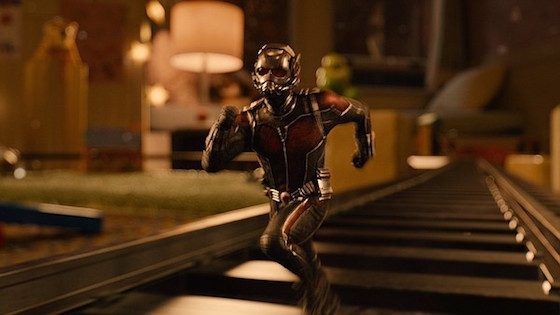This Ant-Man movie review appears at Lawrence.com:
In Avengers: Age of Ultron, the mega-superheroes are taken out of their usual hi-tech, urban surroundings and brought down to Earth when they hide out at a Midwestern farmhouse. It’s a scene that writer/director Joss Whedon had to fight to keep in the movie, and it’s one of the best.
In Marvel’s Ant-Man, the titular character (played by Paul Rudd) suffers an even more ignoble juxtaposition: He’s wearing his retro-cool, ’60s spacesuit-looking outfit in a bathroom. While he hides from his roommates behind a shower curtain, and suddenly shrinks down smaller than the tub stopper, running away from the water on filthy porcelain, trying not to get washed down the drain.
One of the biggest pleasures in the tonally challenged Ant-Man is its overall subversion of the superhero genre. The movie still feels like a Marvel product — and it suffers from a typically one-dimensional bad guy (Corey Stoll) — but it also has a lot of fun turning expectation on its head.
The irony of Ant-Man is that while its action scenes and characters feel small and insignificant in the larger picture of Marvel superheroes who consistently save the world, the piece of new technology introduced in the film couldn’t be bigger.
The “Pym particle,” named after its inventor Hank Pym (Michael Douglas), is a game–changer for the entire universe, and something Pym has been hiding from the military ever since trying it out himself in secret.
When his protege Darren Cross (Stoll) develops a suit called Yellowjacket some 25 years later and is eager to give it up to the highest bidder, Pym chooses a good man in a desperate situation to wear his original Ant-Man outfit and stop the sale.
That man is Scott Lang (Rudd), a hacker/cat burglar with a master’s degree in electrical engineering. After a brief stint in prison, he’s trying to “go straight” for his daughter but he can’t even keep a job at Baskin-Robbins.
He eventually gives up and plans a heist with a group of criminals specifically designed for comic relief. Rudd is his usual likable self, and he’s perfect for a role that requires a lot of exasperation. He’s an everyman that’s easy to root for from the get-go, and his droll sense of humor allows him to comment on the stranger goings-on with the appropriate amount of “WTF?”
The script for Ant-Man was written by original director Edgar Wright and his collaborator Joe Cornish, and then was re-written by Rudd and Adam McKay after Wright left the project. It’s full of Wright’s signature surreal comic touches, especially in the action scenes, which is where Ant-Man at once feels like an extension of and departure from the Marvel Cinematic Universe.
When it tries to explain things such as how Ant-Man can summon a colony of ants, Pied Piper-style, however, the script doesn’t really stick the landing. As Team America so eloquently put it: “We’re gonna need a montage!”
Reed has some trouble balancing the more ridiculous aspects of a character that most people wouldn’t go near, but that’s also part of the fun of Ant-Man. Marvel proved last year with a talking raccoon in Guardians of the Galaxy that the studio isn’t afraid to get weird, so it’s nice to see it still taking some chances.
What Ant-Man is missing that Guardians had is a certain level of confidence. Guardians established a smart-alecky tone from the get-go that was reinforced by those characters during their journey, while Ant-Man feels a little more all over the place.
Still, it’s refreshing to see a Marvel movie that has the opportunity to end with a big action climax in a sleek, hi-tech facility and then purposefully move away to a polar opposite environment. If you’ve seen the trailer, this part of the movie has probably already been given away, but I hadn’t, so I when Ant-Man fought Yellowjacket, I was giggling like a schoolboy throughout.











Comments on this entry are closed.